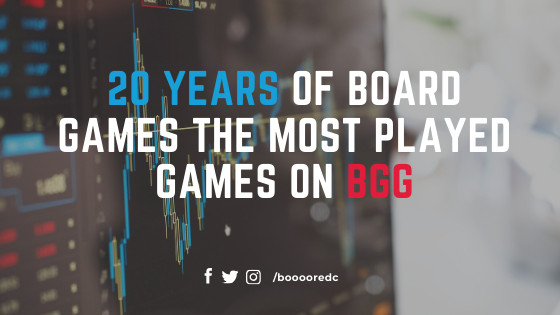Over the last 20 years, the world of board games has changed dramatically with more and more new games being released every year and the hobby becoming more popular than ever its one of the greatest times to be into board gaming.
But what’s changed over the past 20 years one YouTuber and board gamer Eran Hirsch decided to explore this question using data from the popular board game site boardgamegeek.com. The website has a feature that allows users to indicate how many times they have played a board game and found some interesting results.
Here are the top 10 Most Played games as logged by the users of boardgamegeek.com
Please note: these results are based on users of bgg logging the games they played and may not reflect the board game community as a whole but hey its still really interesting. If you don’t like the data because you think your favourite game should be at the top you can help it record the games you play and contribute to the community.
Number 5 – Welcome To….
Number 4 – Gloomhaven
Number 3 – Azul
Number 2 – Terraforming Mars
Number 1 – Wingspan
Check out Eran Hirsch full recap of the data by clicking the video below
Comments from the Creator Eran Hirsch
- The data is obviously biased towards the kind of people that log plays, and the kind of games they play, but surprisingly the results weren’t as skewed as I expected them to be.
- The numbers represent sessions, and not plays, so that the results aren’t biased towards quicker games which might be played as a few rounds in a single session (for example, Love Letter vs Terraforming Mars).
- I used 4 months as a time window because I am limited by the charting tool to 60 dates.
- Some popular games have a popular digital version (Dominion, 7 Wonders, etc…). The data model in BGG doesn’t have a way to differentiate them while logging the play (only a Location field). There are ways to project and account for the digital plays, but I decided to simplify stuff (and not introduce accidental biases) by ignoring this fact.
- The captions showing up every year represent the Golden Geek (GG) award voted by the community itself, and the Spiel de Jahres (SdJ) award voted by a panel of judges.
- I set the chart to show 20 entries (and not the default 10) because a lot of the action seemed to happen below the fold (for example award-winning games often don’t top the chart, but do raise in popularity after winning, check out Hanabi in 2013)
- Because of the constant changes, I set the animation speed low enough so there’s time to take everything in.
- The categories are taken from the 8 “family” rankings that BGG track. For most games there is a single one, but for ones which are classified using 2 I picked the one where the game is higher ranked.
- A few of the titles didn’t seem to fit the normal classification. Either the game is broken up into multiple entries (e.g. Unlock), or the expansions are self-contained enough so that people log plays directly on the expansion (e.g. Dominion). I used the game family instead and grouped all entries together.
- The data is based on about 2500 entries in the BGG DB, but is not complete, as there is no direct way to query this data in its entirety. The games were sourced based on rankings, votes, and several lists including reviewers, and trackers. It’s unlikely that the top games for each trimester are missing an entry, but the total counter might be off by a bit.
- The data is based on the BGG XML API (https://boardgamegeek.com/wiki/page/B…) Most of the work to produce this visualization was to automate obtaining the data set itself. I wrote a whole system to interact with the BGG API in Python.
- The chart is completely auto-generated. I didn’t update or “fix” any data point manually. No games are special-cased.

